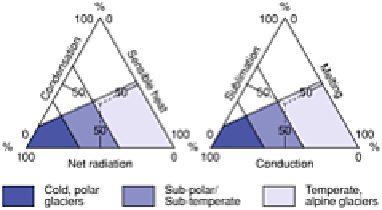Environmental Engineering Reference
In-Depth Information
Figure 2
Ternary diagram of glaciers classified according to
principal energy sources and sinks.
Source: After Andrews (1975).
at first, reaching 0·2 within a few days, but slows considerably thereafter.
Firn
, translated
from German, means literally snow 'from last year' but its typical density of 0·4 is rarely
reached so quickly. It increases faster under higher temperatures and accumulation rates,
exceeding 0·8 within 10-20 a in alpine glaciers but can take 150-200 a in polar ice.
ICE SHELVES AND SEA ICE
Numerous alpine glaciers in Alaska, Chile and New Zealand terminate in
tidewater
-
mostly in fjords - but temperate ice does not possess sufficient tensile strength to allow
them to float. Instead, tides cause the ice to flex and
calve
or release floating icebergs. By
comparison, ice shelves extend from polar ice sheets whose colder ice is stronger. The
Ronne-Filchner and Ross ice shelves, covering 0·75 million km
2
and 0·45 million km
2
respectively, are the largest of a suite of ice shelves fringing 30 per cent of the Antarctic
coast (see Colour Plate 13 between pp. 272 and 273). They account for over 7 per cent of
Antarctic Ice Sheet area. Shelves develop as
piedmont glaciers
fan out into coastal
lowlands from outlet glaciers and float seawards of a
grounding line
when water depth
reaches about 90 per cent of ice thickness, determined by the greater density of sea water
(Plate 15.2). Shelf ice is implicated in glaciomarine processes outlined later.
Sea water freezes at −1·91° C and, except where rapid freezing occurs, loses most of
its salinity on freezing. Initial freezing forms small, crystalline platelets known as
frazil
ice
which coalesce rapidly. A mean thickness of 2·5 m can develop in a single winter and
melt as quickly. Multi-year ice, which is tougher than single-year ice, subsists in less
extreme conditions by basal accretion and surface melt.





